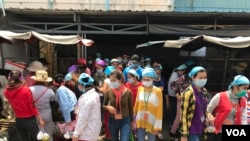Only 35 of the around 15,000 Cambodian migrant workers who returned to the country from Thailand have been tested for the coronavirus, with Interior Minister Sar Kheng admitting the government was incapable of testing everyone.
After Thailand announced it was closing all land border crossings with Cambodia, thousands of Cambodians flocked to the border attempting to get back before the ban was enforced on Sunday. The Interior Minister pegged the number of returnees at 15,000.
However, the Banteay Meanchey Health Department reported that only 35 individuals had been tested for the respiratory disease at the Poipet border crossing, a major checkpoint for the movement of workers and goods between Cambodia and Thailand.
Keo Sopheaktra, director at the Banteay Meanchey Provincial Health Department, said the 35 were tested because they had a high temperature and showed some symptoms, such as a sore throat.
“We have found 35 people on Monday and their sample were sent to Phnom Penh,” Kep Sopheaktra said.
He added that the 35 Cambodians were currently placed under observation at Cambodia-Japan Friendship Hospital and Poipet Referral Hospital.
Interior Minister Sar Kheng admitted Tuesday that Cambodian authorities could not monitor all 15,000 of people nor enforce a 14-day quarantine for all the returnees.
However, he ordered provincial authorities to monitor those who had just returned and search for people who may have had the disease.
“Please explain to them not to touch each other,” he said. “If there is any one in the village who is positive, quarantine the whole family or the whole village.”
The minister’s suggestion to quarantine an entire village is the first instance of a government official suggesting some form of a lockdown, beyond the restrictions on large gatherings already in place.
VOA Khmer could not reach Or Vandine, the Health Ministry’s spokesperson, and Um Reatrey, Banteay Meanchey governor.
Pok Samnang, 32, had been working in a factory in Chonburi province, Thailand, for more than 5 years. He returned through the Poipet border crossing this week and has placed himself in quarantine, using a makeshift enclosure 300 meters from his house, fearing he could have contracted the virus.
“There were so many people when I left. I don’t know who I touched when I was in the car,” Pok Samnang said. “I am not sure if I had it or if they had it. So, I am staying alone because I don’t want to infect my wife and children.”
The Thai Embassy in Phnom Penh said the border closure was needed to stem the spread of the virus, with the best course of action being restriction of movement into the country.
“These social distancing and travel restriction measures are deemed to break the transmission chain. They are based on a whole-of-society approach that need cooperation from all members of the society and all sectors of the economy,” a spokesperson said in an email.
Sum Chankea, ADHOC’s provincial coordinator in Banteay Meanchey, said that provincial authorities were attempting to educate people about the virus but that it was far from sufficient.
“So, I don’t think it can prevent so much. There could be more infection,” he said
As of Wednesday morning, Cambodia had reported 93 cases, most of which were confirmed in the last two weeks.




